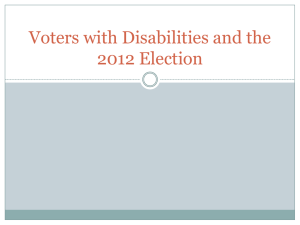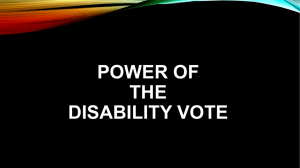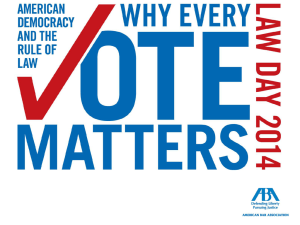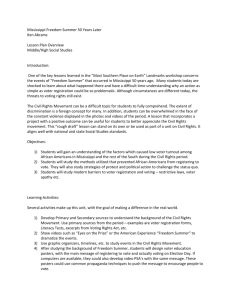Statement on National Voter Refistration Day
advertisement
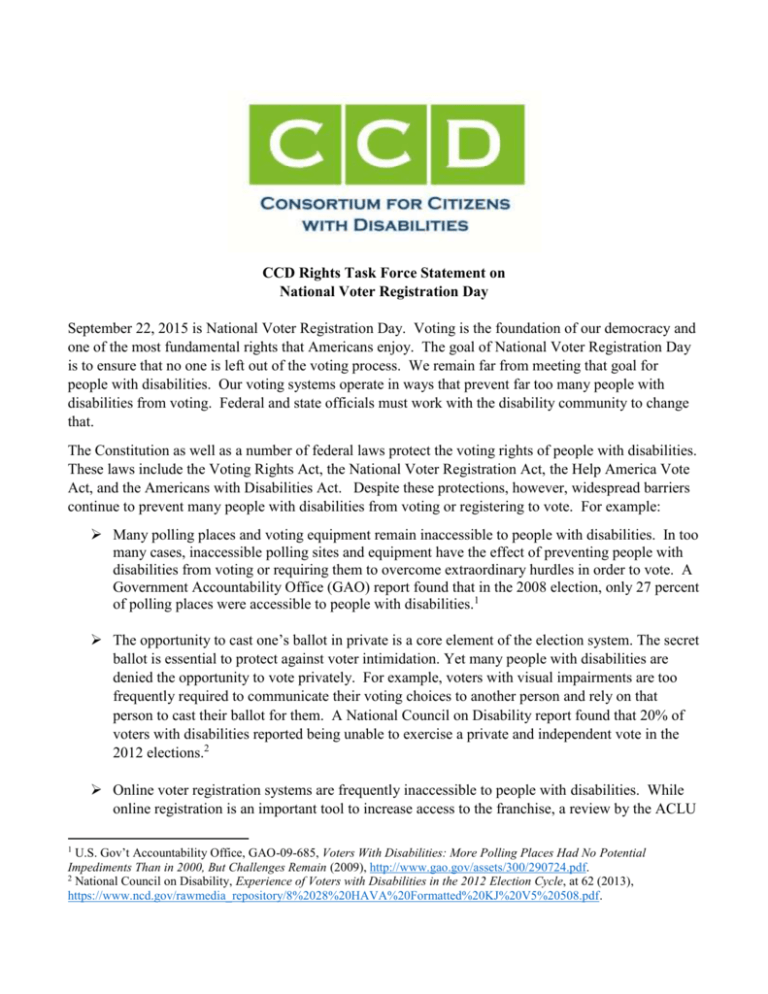
CCD Rights Task Force Statement on National Voter Registration Day September 22, 2015 is National Voter Registration Day. Voting is the foundation of our democracy and one of the most fundamental rights that Americans enjoy. The goal of National Voter Registration Day is to ensure that no one is left out of the voting process. We remain far from meeting that goal for people with disabilities. Our voting systems operate in ways that prevent far too many people with disabilities from voting. Federal and state officials must work with the disability community to change that. The Constitution as well as a number of federal laws protect the voting rights of people with disabilities. These laws include the Voting Rights Act, the National Voter Registration Act, the Help America Vote Act, and the Americans with Disabilities Act. Despite these protections, however, widespread barriers continue to prevent many people with disabilities from voting or registering to vote. For example: Many polling places and voting equipment remain inaccessible to people with disabilities. In too many cases, inaccessible polling sites and equipment have the effect of preventing people with disabilities from voting or requiring them to overcome extraordinary hurdles in order to vote. A Government Accountability Office (GAO) report found that in the 2008 election, only 27 percent of polling places were accessible to people with disabilities.1 The opportunity to cast one’s ballot in private is a core element of the election system. The secret ballot is essential to protect against voter intimidation. Yet many people with disabilities are denied the opportunity to vote privately. For example, voters with visual impairments are too frequently required to communicate their voting choices to another person and rely on that person to cast their ballot for them. A National Council on Disability report found that 20% of voters with disabilities reported being unable to exercise a private and independent vote in the 2012 elections.2 Online voter registration systems are frequently inaccessible to people with disabilities. While online registration is an important tool to increase access to the franchise, a review by the ACLU U.S. Gov’t Accountability Office, GAO-09-685, Voters With Disabilities: More Polling Places Had No Potential Impediments Than in 2000, But Challenges Remain (2009), http://www.gao.gov/assets/300/290724.pdf. 2 National Council on Disability, Experience of Voters with Disabilities in the 2012 Election Cycle, at 62 (2013), https://www.ncd.gov/rawmedia_repository/8%2028%20HAVA%20Formatted%20KJ%20V5%20508.pdf. 1 and the Center for Accessible Technology of the 20 states offering online registration in May 2014 found that only one state’s online voter registration website was fully accessible, and most state websites do not even meet basic standards of accessibility.3 Many people with disabilities are inappropriately prevented from voting due to overbroad voter competence requirements imposed on people with disabilities by state laws or by election officials, poll workers, or disability service providers. These requirements are typically applied only to people with disabilities, and effectively impose higher standards on individuals with disabilities than on others to demonstrate that they should be allowed to vote.4 Any voter competence requirement used must impose the same standard used to determine when voters without disabilities can vote—that they can communicate, with or without accommodations, a choice to participate in the voting process. As the National Council on Disability observed, an increasing number of practices characterized as measures to prevent voter fraud—including laws requiring voters to present photo identification, restrictive voter registration requirements, and inappropriate purging of voter rolls—may create barriers to voting for eligible voters with disabilities and suppress citizen participation in voting.5 The National Council on Disability’s report on the 2012 elections included the following findings: “People with disabilities continue to face barriers in exercising their voting rights because of architectural and physical barriers at registration and polling sites.”6 “Voters with disabilities do not have equal access to voting systems because states and localities have not invested adequate resources, planning, and training to provide reliable, accessible voting technology.”7 “Voters with disabilities face discrimination at voter registration and polling sites resulting from poorly trained election personnel and volunteers.”8 “People with disabilities who are under guardianship face increasing barriers to voting owing to state laws.”9 Current practices, whether purposeful or not, systemically prevent people with disabilities from voting. This disenfranchisement of voters with disabilities is unacceptable. We call on federal and state officials to work with the disability community to eliminate these barriers and ensure full and equal participation by people with disabilities in our voting systems. 3 ACLU & Center for Accessible Technology, Access Denied: Barriers to Online Voting for Citizens with Disabilities (Feb. 2015), https://www.aclu.org/files/022415-ACLU-VoterReg.html. 4 Bazelon Center for Mental Health Law & National Disability Rights Network, Vote. It’s Your Right. A Guide to the Voting Rights of People with Mental Disabilities (2008 and 2012 Addendum), http://www.bazelon.org/LinkClick.aspx?fileticket=8GRTfqaH_Qc%3d&tabid=543, http://www.bazelon.org/LinkClick.aspx?fileticket=szZrfSzI8U0%3d&tabid=543. 5 National Council on Disability, supra note 2, at 98. 6 Id. at 83. 7 Id. at 85. 8 Id. at 88. 9 Id. at 99. 2





